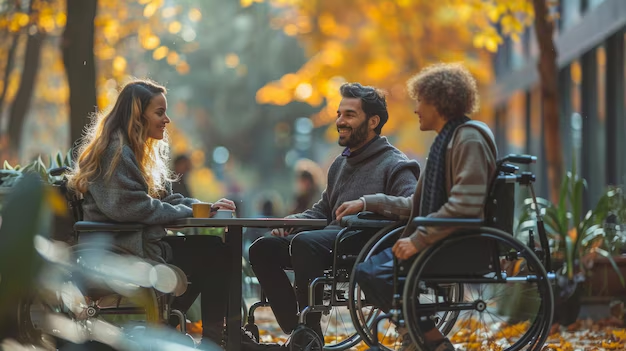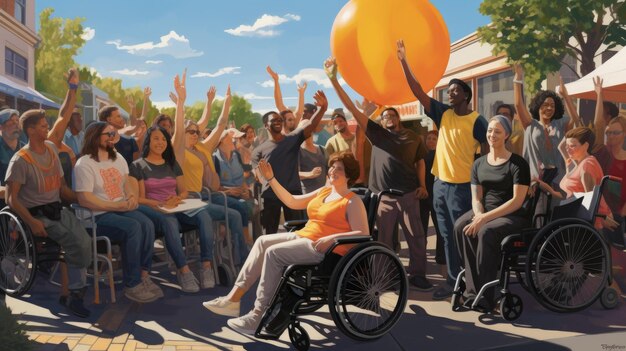Disability Campaigners Are Exasperated: What’s Next? as I think about the stories of discrimination and barriers faced by people with disabilities, I feel a strong sense of frustration. For years, those fighting for disability rights have worked hard for equal rights and inclusion. But, progress has been very slow.
Many people with disabilities are still left out, denied chances, and treated unfairly. It’s time to make their voices heard and demand the change they deserve.

Key Takeaways
- Disability campaigners face immense challenges in achieving accessibility and equal rights for the disabled community.
- Discrimination and stigma continue to hinder the progress towards an inclusive society.
- Empowering disabled individuals through education, employment, and representation is crucial.
- Building an inclusive society requires policy reform and the dismantling of systemic barriers.
Understanding the Frustrations of Disability Campaigners
Disability campaigners work hard for accessibility barriers, social justice for disabled people, and to stop disability discrimination. They face many challenges every day. This makes them very frustrated.
Barriers to Accessibility
One big frustration is the lack of accessibility in many places. Buildings, sidewalks, websites, and apps often don’t work for people with disabilities. This makes it hard for them to be independent and take part in society. Disability awareness is key, but many places don’t think about the needs of disabled people.
Discrimination and Stigma
There’s also a lot of disability discrimination and stigma. People with disabilities often face prejudice and don’t get the same chances as others. This makes them feel left out and lowers their self-esteem. It also stops them from getting good jobs, education, and social justice.
Disability campaigners have many reasons to be frustrated. They deal with both physical and mental barriers. The fight for inclusion and equality is very important and urgent.

Disability Campaigners Are Exasperated: A Call for Change
In the United States, disability rights advocates are getting more upset. They feel there’s not enough progress towards true equality for the disabled. Despite hard work, barriers to accessibility, discrimination, and stigma still exist.

These campaigners feel the daily struggles of people with disabilities. They face problems getting into public places, finding jobs, and being part of society. Now, they’re asking for a big change in how we handle disability rights.
One activist said, “We’ve had enough of empty promises. It’s time for real action that solves the problems of exclusion and lets disabled people live with dignity.”
A Comprehensive Approach to Disability Rights
For change, campaigners want a detailed plan for disability rights. This plan covers different parts of the movement:
- Strong laws to make sure public places are accessible to everyone.
- Rules against discrimination in jobs, schools, and life.
- More money for programs that help disabled people, like rehab and tech.
- More disabled people in media, politics, and making decisions.
- Campaigns to change wrong ideas about disability.
This detailed plan aims to break down barriers that stop disabled people from fully joining our society.

We can’t just keep making small steps. Disability campaigners want big changes. They dream of a society where everyone has equal chances, can get into places easily, and is included. This would be a place where everyone’s abilities are valued.
Empowering Disabled Individuals
Helping disabled people is key to a fair and welcoming world. We must tackle the hurdles they face to let them shine and get the support they need.
Inclusive Education and Employment
Education and jobs that welcome everyone are crucial. They help disabled people reach their goals and be independent. By making learning and work spaces welcoming, we help them succeed.
- Creating learning spaces that everyone can get into
- Offering jobs that can be done from home or with flexibility
- Making sure workplaces are easy for everyone to use
Representation and Visibility
Seeing disabled people in media and leadership helps break down barriers. It makes society more open and understanding. By sharing their stories, we build a world that values everyone’s unique views.
- Showing real and varied disabled characters in stories
- Putting disabled people in important roles
- Listening to the disabled community when making big decisions
With education, jobs, and visibility, we can make a society that values everyone. It’s about celebrating our differences and working together.
Disability Rights Advocacy: Strategies and Approaches
The disability rights movement uses many strategies to fight for equal rights. These include grassroots activism, policy changes, legal actions, and working together. The goal is to make society more inclusive for everyone.

At the core, grassroots movements empower people with disabilities to speak out and demand their rights. These efforts highlight the barriers and discrimination they face. They give a voice to the disabled community.
Policy advocacy is also key in making laws that protect disabled people’s rights. Advocates work hard to influence those who make decisions. They make sure the disabled community’s needs are heard.
Legal challenges are another strong tool for disability rights. Activists use courts to fight against discrimination. They aim to hold institutions accountable and set important precedents.
Working together is vital for real change. Disability rights advocates team up with other groups for a stronger voice. This unity helps push for equity and inclusion.
This wide-ranging approach has made big progress in promoting disability rights advocacy and social justice for the disabled. Yet, the path to a fully inclusive society is long. The dedication and strength of advocates will be key to creating a better future.
Building an Inclusive Society
Making a society where everyone, including those with disabilities, feels included is key. We need to change laws and policies to make this happen. People who make laws, supporters, and the community must work together. They need to remove the barriers that have kept people with disabilities from having the same rights and chances as others.
Policy Reform and Implementation
Changing policies for the better starts with seeing what’s wrong with the current laws. Disability advocates have been saying we need stronger laws against discrimination, better access for everyone, and more money for programs that help include everyone.
It’s also important to put these new policies into action. Governments need to use enough money, make sure everyone follows the rules, and check if the new plans are working. Working with groups led by people with disabilities is key. It makes sure the changes meet the real needs and views of the community.
| Policy Area | Key Reforms Needed |
|---|---|
| Education | Inclusive curriculum, accessible infrastructure, teacher training on disability awareness |
| Employment | Targeted hiring programs, workplace accommodations, anti-discrimination protections |
| Transportation | Affordable, accessible public transit options, stricter regulations on vehicle accessibility |
| Healthcare | Comprehensive coverage for assistive technologies, mental health services, and rehabilitation |
By making and following these policy changes, we can move closer to a society that welcomes everyone. This means people with disabilities can fully join in all parts of life.
Disability Pride and Awareness
In recent years, the disability rights movement has grown strong. People with disabilities are proudly showing who they are and fighting for more inclusion. They celebrate their unique experiences and strengths, fighting against old stereotypes and wrong ideas.
Challenging Stereotypes and Misconceptions
For a long time, people with disabilities faced harmful stereotypes. These ideas made them feel left out and discriminated against. People thought they couldn’t do much and were a burden.

But now, the disability pride movement is fighting back. It’s showing the world the real stories and talents of people with disabilities. They’re taking back their stories through media, arts, and leadership.
Education and awareness campaigns are also helping. They talk openly about disability and what people with disabilities bring to society. This helps make society more welcoming and understanding.
The movement is about more than just fighting wrong ideas. It’s about helping people with disabilities love who they are and their experiences. Seeing disability as a strength, not a weakness, can really change things.
As the disability rights movement grows, we all need to support it. We should help make sure people with disabilities are seen, heard, and valued. By promoting disability pride and awareness, we can make a world where everyone can reach their goals.
Conclusion
Throughout this article, we’ve seen how disability campaigners are upset. They face ongoing barriers to accessibility, discrimination, and lack of equal chances. We need to take action fast to fix these big issues and make a society that includes everyone.
We must work harder to support disability rights and make things more accessible. This means giving disabled people better education and job chances. It also means showing them they are seen and heard, to fight the old ideas that have held us back.
Creating a fair and inclusive world for everyone is up to us. We need to listen to disability campaigners and join forces to make a better future. A future where disabled people can do well, make a difference, and live with dignity and respect.
FAQ
What are the main sources of frustration for disability campaigners?
Disability campaigners face many barriers. These include lack of accessibility in public places, transport, and online. They also deal with discrimination and stigma. These issues make it hard for people with disabilities to have equal opportunities and live normally.
Why is there a growing sense of urgency among disability campaigners?
There’s a growing urgency because campaigners keep facing obstacles. They want equal rights and full inclusion for everyone with disabilities. There’s a need for quick and effective action to solve these problems and push for change.
How can disabled individuals be empowered and supported?
To empower and support disabled individuals, we need to make education and jobs accessible. We should also increase their presence in media, leadership, and decision-making. This will help them have a stronger voice.
What are the key strategies and approaches used by disability rights advocates?
Disability rights advocates use many strategies. These include grassroots movements, pushing for policy changes, legal actions, and working together. Their goal is to bring about systemic change and equality for the disabled community.
What policy reforms are needed to create a more inclusive society?
We need broad policy reforms to make society more inclusive. It’s important to focus on the rights and accessibility of people with disabilities. We should look at successful reforms and work on areas that need improvement.
How can disability pride and awareness be promoted?
To promote disability pride and awareness, we need more visibility and education. By challenging negative stereotypes and misconceptions, we can build a more accepting society. This will help create a place where everyone feels included.






